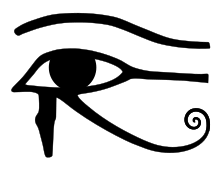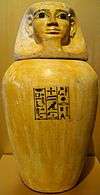Hapi (Son of Horus)
Hapi, sometimes transliterated as Hapy, is one of the Four sons of Horus in ancient Egyptian religion, depicted in funerary literature as protecting the throne of Osiris in the Underworld. Hapi was the son of Heru-ur and Isis or Serqet. He is not to be confused with another god of the same name. He is commonly depicted with the head of a hamadryas baboon, and is tasked with protecting the lungs of the deceased, hence the common depiction of a hamadryas baboon head sculpted as the lid of the canopic jar that held the lungs. Hapi is in turn protected by the goddess Nephthys.[1] When his image appears on the side of a coffin, he is usually aligned with the side intended to face north.[2] When embalming practices changed during the Third Intermediate Period and the mummified organs were placed back inside the body, an amulet of Hapi would be included in the body cavity.[2]
| Part of a series on |
| Ancient Egyptian religion |
|---|
 |
|
Beliefs |
|
Practices
|
|
Deities (list) |
|
Locations |
|
Symbols and objects
|
|
Related religions
|
|
|
| Hapi in hieroglyphs |
|---|
Since drowning was the form of death associated with the lungs, the deity gained the name geese, in reference to floating on water. The spelling of his name includes a hieroglyph which is thought to be connected with steering a boat, although its exact nature is not known. For this reason he was sometimes connected with navigation, although early references call him the great runner, as below from Spell 521 of the Coffin Texts.
You are the great runner; come, that you may join up my father N and not be far in this your name of Hapi, for you are the greatest of my children – so says Horus"[3]
In Spell 151 of the Book of the Dead he is given the following words to say:
I have come that I may be your protection, O N; I have knit together your head and your members, I have smitten your enemies beneath you, and I have given you your head forever.[4]
As one of the four pillars of Shu and one of the four rudders of heaven he was associated with the North, and is specifically referenced as such in Spell 148 in the Book of the Dead.
 Hapi-(lung) Canopic jar of "Lady Senebtisi"
Hapi-(lung) Canopic jar of "Lady Senebtisi"
God Hapi is spelled in Egyptian language hieroglyphs: "h-p-(det.–Rudder)"- Hapi in the Übersee-Museum
See also
- Four sons of Horus – in-depth treatment of the Four sons and their interrelationships.
References
- David B. O'Connor, Eric H. Cline, Amenhotep III: Perspectives on His Reign, University of Michigan Press 1998, ISBN 0-472-08833-5, p.121.
- Wilkinson, Richard H. The Complete Gods and Goddesses of Ancient Egypt. p.88 Thames & Hudson. 2003. ISBN 0-500-05120-8
- Raymond Oliver Faulkner, The Ancient Egyptian Coffin Texts, p.521. David Brown Book Company 2004
- Raymond Oliver Faulkner, The Ancient Egyptian Coffin Texts, David Brown Book Company 2004
External links
